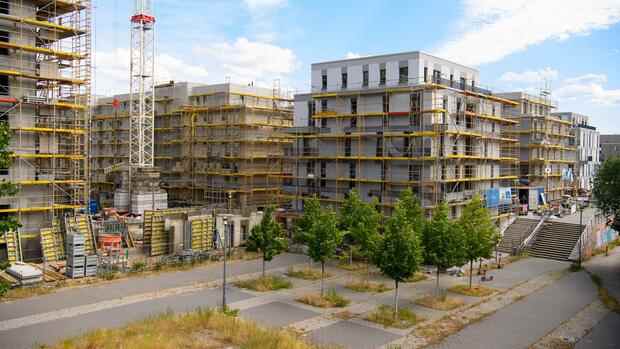There is still a lot of unused building space in metropolitan areas, as a new study shows.
(Photo: dpa)
Berlin The coalition agreement between the SPD, Greens and FDP promises a “departure in construction, housing and urban development policy”. Apartments are in short supply, especially in metropolitan areas – one reason for rising prices and rents. The federal government has therefore set itself the goal of providing 400,000 new apartments per year by 2025, 100,000 of them in subsidized public housing.
So far, it was the building permits that had already been granted that made Federal Building Minister Klara Geywitz believe in the feasibility of this goal. Now there is a new argument: the availability of building land. “We have potential from north to south, from east to west,” said the SPD politician at the presentation of the building land study this Tuesday.
With a cautious estimate based on the usual use up to now, there is building land available nationwide for at least around 900,000 residential units, Geywitz said. With denser development or use, there are also significantly more, up to more than four million residential units. “As a practical person, I would say that the good middle, two million, would be quite achievable.”
The main result of the survey is that there is also a lot of unused space for residential construction in inner cities. In this way, the amount of newly designated areas on the green field can be limited. The government has also set itself the goal of reclaiming less than 30 hectares of land per day by 2030.
Top jobs of the day
Find the best jobs now and
be notified by email.
“We can no longer afford to waste land, both economically and ecologically,” said the Federal Minister for Building. One therefore wants to use the potential that lies dormant in the municipalities. According to the Federal Statistical Office, in the four-year average from 2017 to 2020, the settlement and traffic area in Germany grew by around 54 hectares per day.
The study is published by the Federal Institute for Research on Building, Urban Affairs and Spatial Development (BBSR). The team of authors also includes scientists from the Leibniz Institute for Ecological Spatial Development (IÖR) and the Cologne Institute for Economic Research (IW). 692 cities and municipalities took part in the survey.
Read here: role model or not? How good Hamburg is as a model for residential construction
The study shows “that there is sufficient space for residential construction,” said BBSR boss Markus Eltges. But there are other challenges: It is now important “to make these areas ready for construction quickly, to involve the local population in the planning processes at an early stage and to use serial production methods”. This could shorten construction times and at least partially counteract the shortage of skilled workers in the construction sector.
The study identifies three area categories:
internal development potential
Public and private areas – derelict areas and vacant lots – in developed settlement areas. The study sees a potential of at least around 84,000 hectares here. Fallow land makes up around 40 percent, vacant lots around 60 percent.
Building land reserves ready for building
Public and private areas outside established settlement areas that are intended for structural use or the development of green and recreational areas. This also includes brownfields. Together, the interior development potential and the building land reserves that are ready for building make up an area of at least around 99,000 hectares. This corresponds to an area of 140,000 football pitches. Of these, around 55 percent are assessed as directly usable or as mobilizable in the short term.
The plan is to use the space primarily for apartments at 65 percent, followed by commercial space at just under 25 percent. Around 3.5 percent of the areas are earmarked for greenery and recreation. The rest is accounted for by unknown uses.
Long-term building land potential
Areas that are intended for structural use but for which there is not yet a development plan. Here, the information from the cities and municipalities surveyed add up to more than 130,000 hectares.
In addition to this area potential, it is said that there is potential for densification in existing quarters. Examples of this are adding storeys or loft conversions, as well as infrastructure or traffic areas that can be built over, as well as second-row development, courtyard development and other supplementary buildings.
More: There is a lack of apartments in Germany: These seven measures should alleviate the problem.
